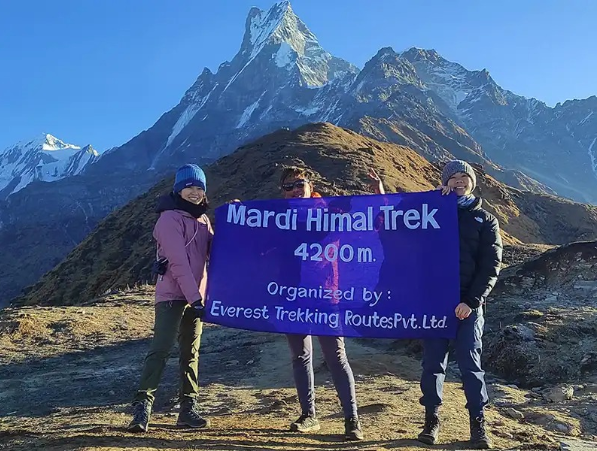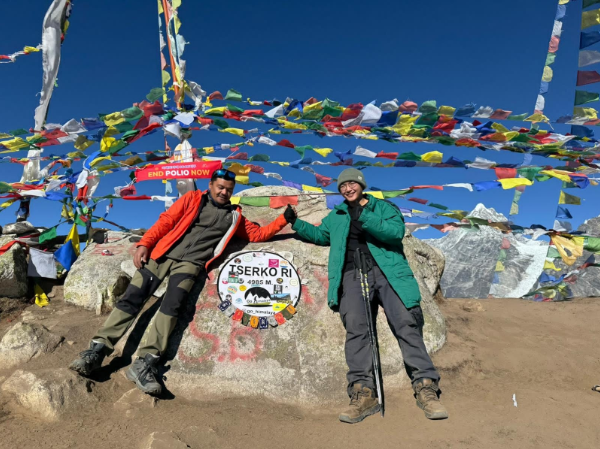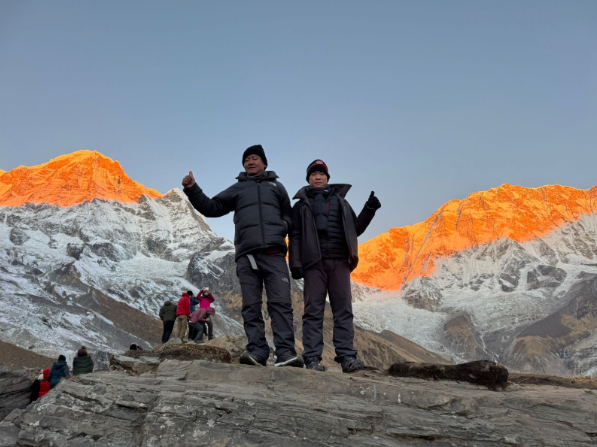The (ABC) trek is a classic Himalayan adventure, leading you through diverse landscapes to the foot of the majestic Annapurna I (8,091m). This moderate-to-strenuous trek is renowned for its accessibility and stunning panoramic views.
Highlights:
- Spectacular scenery: Witness breathtaking vistas of Annapurna I, Annapurna South, Machapuchare (Fishtail), and other snow-capped giants.
- Diverse landscapes: Traverse lush rhododendron forests, charming Gurung villages, and alpine meadows.
- Cultural immersion: Experience the rich culture and hospitality of the local communities.
- Reaching the base camp: Stand in awe at the Annapurna Base Camp, surrounded by towering peaks.
Trek Details:
- Duration: 10-14 days
- Difficulty: Moderate to Strenuous
- Best Season: October-November and March-April
Considerations: Altitude sickness is a potential concern. Acclimatization is crucial. Permits are required (Annapurna Conservation Area Permit (ACAP) and TIMS card). Teahouses provide accommodation and meals along the trail.
Mardi Himal Trek: A Hidden Gem in the Annapurna Region
The Mardi Himal Trek is a relatively new and less crowded alternative to the ABC trek, offering a more secluded and pristine experience. This short but challenging trek takes you to the base camp of Mardi Himal, providing stunning close-up views of Machapuchare.

Highlights:
- Off-the-beaten-path experience: Enjoy a quieter and more intimate trekking experience.
- Close-up views of Machapuchare: Marvel at the majestic “Fishtail” peak from a unique perspective.
- Scenic ridgeline trekking: Hike along a scenic ridgeline with panoramic mountain views.
- Relatively shorter duration: Ideal for those with limited time.
Trek Details:
- Duration: 5-7 days
- Difficulty: Moderate to Strenuous
- Best Season: October-November and March-April
Considerations: The trail can be steep and challenging in some sections. Basic teahouse accommodation is available. Permits (ACAP and TIMS) are required.
Langtang Valley Trek: A Trek Through Tibetan-Influenced Landscapes
The Langtang Valley Trek offers a unique cultural experience, taking you through Tamang villages with strong Tibetan influences. This trek is known for its beautiful landscapes, including lush forests, alpine meadows, and glaciers.

Highlights:
- Tibetan culture: Explore Tamang villages and monasteries, experiencing their unique culture and traditions.
- Langtang National Park: Discover diverse flora and fauna within the park.
- Glacier views: Witness stunning views of Langtang Lirung and other snow-capped peaks.
- Relatively accessible: A good option for those seeking a less strenuous trek.
Trek Details:
- Duration: 7-10 days
- Difficulty: Moderate
- Best Season: October-November and March-April
Considerations: The valley was significantly affected by the 2015 earthquake, but the trekking infrastructure has been rebuilt. Permits (Langtang National Park Entry Permit and TIMS) are required.
Manaslu Circuit Trek: A Challenging and Rewarding Adventure
The Manaslu Circuit Trek is a challenging but incredibly rewarding trek that circumnavigates the eighth highest mountain in the world, Mount Manaslu (8,163m). This remote and less crowded trek offers a unique blend of natural beauty and cultural immersion.
Highlights:
- Remote and pristine landscapes: Explore untouched and breathtaking mountain scenery.
- Cultural encounters: Interact with diverse ethnic groups and experience their unique traditions.
- Challenging passes: Cross high-altitude passes like Larkya La (5,106m).
- Stunning mountain views: Witness magnificent views of Manaslu, Annapurna, and other Himalayan giants.
Trek Details:
- Duration: 14-18 days
- Difficulty: Strenuous
- Best Season: October-November and March-April
Considerations: This trek is physically demanding and requires a good level of fitness. Altitude sickness is a serious concern. Restricted Area Permit (RAP) and Manaslu Conservation Area Permit (MCAP), along with TIMS card, are required. Organized treks with a licensed guide are mandatory.
Conclusion: Choosing Your Himalayan Adventure
Each of these treks offers a unique and unforgettable Himalayan experience. The Annapurna Base Camp trek is a classic choice for its accessibility and stunning views. The Mardi Himal trek provides a more secluded and pristine experience. The Langtang Valley trek offers a blend of natural beauty and cultural immersion. And the Manaslu Circuit trek is a challenging but rewarding adventure for experienced trekkers. Carefully consider your fitness level, time constraints, and interests when choosing your Himalayan adventure. Prepare well, respect the local culture, and embrace the magic of the Himalayas.
Key Takeaways
| Trek Name | Duration | Difficulty | Best Season | Permits Required | Key Features |
| Annapurna Base Camp | 10-14 days | Moderate-Strenuous | Oct-Nov, Mar-Apr | ACAP, TIMS | Classic trek, diverse landscapes, panoramic views |
| Mardi Himal | 5-7 days | Moderate-Strenuous | Oct-Nov, Mar-Apr | ACAP, TIMS | Off-the-beaten-path, close-up Machapuchare views |
| Langtang Valley | 7-10 days | Moderate | Oct-Nov, Mar-Apr | Langtang NP Entry Permit, TIMS | Tibetan culture, Langtang National Park, glaciers |
| Manaslu Circuit | 14-18 days | Strenuous | Oct-Nov, Mar-Apr | RAP, MCAP, TIMS | Remote, challenging, diverse cultures, high passes |
Export to Sheets
FAQs
Q: What is the best time to trek in Nepal?
A: The best time to trek in Nepal is during the pre-monsoon (March-April) and post-monsoon (October-November) seasons. These periods offer clear skies, moderate temperatures, and less rainfall.
Q: Do I need a visa for Nepal?
A: Yes, most nationalities require a visa for Nepal. You can obtain a visa on arrival at Tribhuvan International Airport in Kathmandu or at designated entry points.
Q: What kind of gear do I need for trekking in Nepal?
A: The gear you need will depend on the specific trek and the time of year. Generally, you will need sturdy hiking boots, warm layers of clothing, a waterproof jacket, a sleeping bag, a first-aid kit, and a water bottle or hydration system.
Q: How much does it cost to trek in Nepal?
A: The cost of trekking in Nepal varies depending on the trek, duration, and level of comfort. Budget treks using teahouses are generally more affordable than luxury treks.
Q: Is it safe to trek in Nepal?
A: Trekking in Nepal is generally safe, but it is important to be aware of potential risks, such as altitude sickness, weather changes, and trail conditions. Hiring a licensed guide and porter is recommended, especially for challenging treks.
Q: What is altitude sickness and how can I prevent it?
A: Altitude sickness is a common problem at high altitudes. Symptoms can include headache, nausea, fatigue, and shortness of breath. To prevent altitude sickness, ascend gradually, stay hydrated, avoid alcohol and smoking, and consider taking altitude sickness medication if recommended by your doctor.
Q: What is a teahouse?
A: A teahouse is a small lodge or guesthouse that provides accommodation and meals to trekkers along the trail. Teahouses are a common form of accommodation on popular trekking routes in Nepal.
Q: Do I need travel insurance for trekking in Nepal?
A: Yes, travel insurance is highly recommended for trekking in Nepal. Make sure your insurance policy covers medical expenses, emergency evacuation, and trip cancellation.
Q: How can I be a responsible trekker?
A: Be a responsible trekker by respecting the local culture and customs, minimizing your environmental impact, supporting local businesses, and practicing Leave No Trace principles.
Contact Us;
Everest Trekking Routes Pvt. Ltd.
Khumbu, Nayabazaar, Kathmandu, Nepal
Mobile : +977-9843467921 (Rabin)
Email: info@everesttrekkingroutes.com
URL:- www.everesttrekkingroutes.com

